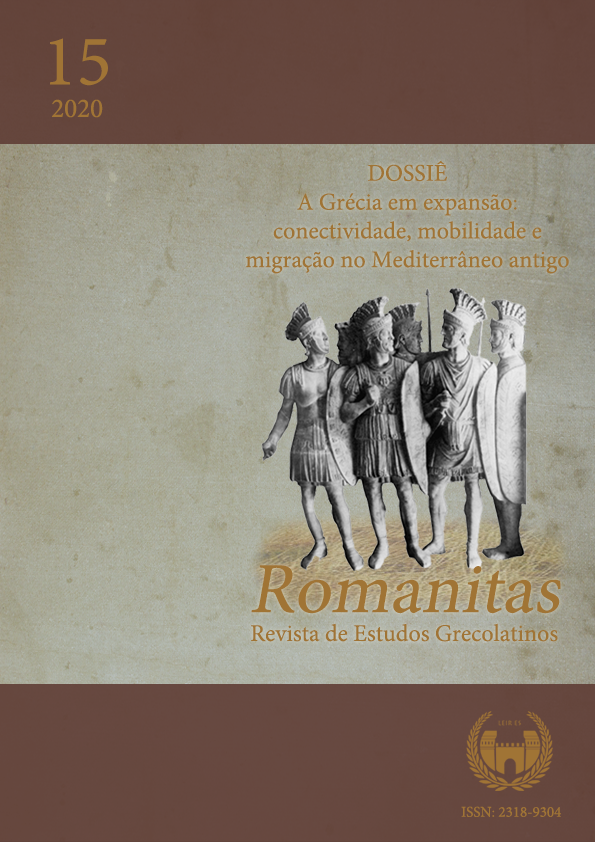Days of glory: an analysis of Octavian’s triple triumph in 29 B.C.
DOI:
https://doi.org/10.17648/rom.v0i15.25213Keywords:
Triple Triumph, Octavian, Architecture, MemoryAbstract
In August of 29 BC, Rome witnessed a great event, the triumph of Octavian. A ceremony that exalted the victories of the Imperator Caesar and of his troops and exhibited the conquered riches. The triumphal procession linked past, present, and future. It was connected, in its origin, with the founder of Rome and first triumphator, Romulus; it celebrated in the present moment the victories of the triumphator general, exhibiting the vanquished peoples and the riches brought as war booty; and inscribed the name of the victor in the memory of future generations, both for the achievement, and for the memorable triumph that went through the streets of Rome, as well as for the monuments and / or buildings that could be erected with the war booty. In this work we analyze this great event and its relations with the architecture and the memory.
Downloads
References
Documentação textual
AUGUSTUS. Res Gestae Divi Augusti. English translation by Frederick W. Shipley. London: Harvard University Press, 1961.
DIO CASSIUS. Dio’s Roman history. English translation by Earnest Cary. Cambridge: Harvard University Press, 1924.
DIONYSIUS OF HALICARNASSUS. The Roman antiquities. English translation by Earnest Carry. London: William Heinemann, 1960.
FLAVIUS JOSEPHUS. The Wars of the Jews. English translation by William Whiston. Auburn: John E. Beardsley, 1895.
PLUTARCH. The Life of Antony. In: PLUTARCH. The Parallel Lives. English translation by. Bernadotte Perrin. London: William Heinemann, 1919.
PROPERTIUS. Elegies. Editing and translation by G. P. Gold. Cambridge: Harvard University Press, 1990.
SUETONIUS. Life of Augustus. In: SUETONIUS. Lives of the Caesars. English translation by J. C. Rolfe. London: William Heinemann, 1914.
TITUS LIVIUS. History of Rome. English translation by Canon Roberts. London: Everyman’s Library Classical, 1905.
Obras de referência
RICHARDSON, L. A New topographical dictionary of ancient Rome. London: Johns Hopkins University Press, 1992.
Obras de apoio
BEARD, M. The Roman Triumph. Cambridge: Harvard University Press, 2007.
EVERITT, A. Augusto: el primer emperador. Barcelona: Ariel, 2008.
FAVRO, D. The street triumphant: the urban impact of Roman triumphal parades. In: ÇELIK, Z.; FAVRO, D.; INGERSOLL, R. (Ed.). Streets: critical perspectives on public space. Los Angeles: University of California Press, 1994, p. 151-164.
FAVRO, D. The urban image of Augustan Rome. Los Angeles: Cambridge University Press, 2008.
FAVRO, D.; JOHANSON, C. Death in motion: funeral processions in the Roman Forum. Journal of the Society of Architectural Historians, v. 69, n. 1, p. 12–37, 2010.
GONÇALVES, A. T. M. A noção de propaganda e sua aplicação nos estudos clássicos: o caso dos imperadores romanos Septímio Severo e Caracala. Jundiaí: Paco, 2013.
HICKSON, F. V. Augustus “Triumphator”: manipulation of the triumphal theme in the political program of Augustus. Latomus, t. 50, f. 1, p. 124-138, 1991.
HOLLAND, L. B. The triple arch of Augustus. American Journal of Archaeology, v. 50, n. 1, p. 52-59, 1946.
HÖLSCHER, T. The transformation of victory into power: from event to structure. In: DILLON, S.; WELCH, K. E. (Ed.). Representations of war in Ancient Rome. Cambridge: Cambridge University Press, 2006, p. 27-48.
HOPE, V. The city of Rome: capital and symbol. In: HUSKINSON, J. (Ed.). Experiencing Rome: culture, identity and power in the Roman Empire. New York: Routledge, 2005, p. 63-93.
KEARSLEY, R. Octavian and Augury: the years 30-27 B.C. The Classical Quarterly, v. 59, n. 1, p. 147-166, 2009.
KLEINER, F. The study of Roman triumphal and honorary arches 50 years after Kähler. Journal of Roman Archaeology, v. 2, p. 195-206, 1989.
LANGE, C. H. Res Publica Constituta: Actium, Apollo and the accomplishment of the Triumviral Assignment. Leiden: Brill, 2009.
MARTINS, P. Imagem e poder: considerações sobre a representação de Otávio Augusto. São Paulo: Edusp, 2011.
POPKIN, M. L. The architecture of the Roman Triumph: monuments, memory and identity. New York: Cambridge University Press, 2016.
SCHEID, J. Augustus and Roman religion. In: GALINSKY, K. (Ed.). The Age of Augustus. New York: Cambridge University Press, 2007, p. 175-193.
SILVA, C. F. P. A construção da imagem de Otávio, Cleópatra e Marco Antônio entre moedas e poemas (44 a 27 a.C.). 2014. 189 f. Dissertação (Mestrado em História) – Programa de Pós-Graduação em História Social das Relações Políticas, Universidade Federal do Espírito Santo, Vitória, 2014.
TARPIN, M. Le triomphe d’Auguste: héritage de la République ou révolution?. In: HURLET, F.; MINEO, B. (Dir.) Le Principat d’Auguste: realités et répresentations du pouvoir autour de la Res publica restituta. Rennes: Presses Universitaires de Rennes, 2009, p. 129-142.
TRONSON, A. What the poet saw: Octavian’s Triple Triumph, 29 B.C. Jeremiah Markland’s conjectures at Propertius 3.11.52-53. Acta Classica, v. 42, p. 171-186, 1999.
Downloads
Published
Issue
Section
License
Copyright (c) 2020 Romanitas - Revista de Estudos Grecolatinos

This work is licensed under a Creative Commons Attribution-NonCommercial-NoDerivatives 4.0 International License.
a. The authors retain copyright and grant the journal the right to first publication.
b. The authors are authorized to assume additional contracts separately, for non-exclusive distribution of the version of the work published in this journal (e.g., publishing in institutional repository or as a book chapter), with acknowledgment of authorship and initial publication in this journal.
c. Authors are allowed and encouraged to publish and distribute their work online (e.g. in institutional repositories or on their personal page) after the first publication by the journal, with due credit.
d. The journal's texts are licensed under a CC BY 4.0 Deed Attribution 4.0 International Licence (CC BY).

























